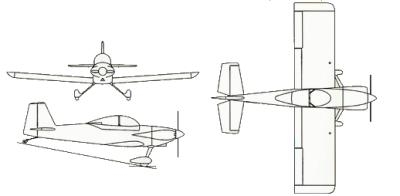ATP-Rated Pilot, Passenger Fatally Injured After Encountering Deteriorating Weather
The NTSB has issued a preliminary report from an accident which occurred 17, 2015 involving an RV-4, and the report tells a cautionary tale about an experienced pilot becoming involved in a loss-of-control accident.

According to the report, on that date at about 1938 eastern standard time (EST), the RV-4 collided with terrain following an in-flight loss of control near Greenville, Florida. The airline transport-rated pilot and one passenger were fatally injured. The airplane was destroyed by impact forces. The experimental, amateur-built airplane was registered to the pilot under the provisions of Title 14 Code of Federal Regulations Part 91 as a personal flight. Night, instrument meteorological conditions prevailed at the time of the accident, and no flight plan was filed. The flight originated from Apopka, Florida (X04) and was destined for Tallahassee, Florida (TLH).
According to preliminary information obtained from air traffic control, the airplane was at 2,500 feet above mean sea level (msl), approaching the TLH area from the east. Jacksonville Air Route Traffic Control Center (JZX) was providing VFR flight following services to the pilot. The JZX controller informed the pilot that there was moderate precipitation in the area, and the pilot informed JZX that he would deviate "a little to the north." About 45 seconds later, the pilot informed JZX that he would be diverting to Thomasville (Georgia) Regional Airport (TVI) for "better weather." Following a handoff to TLH approach control, the pilot reported that he was declaring an emergency. He advised the controller that he was in IFR conditions and was not capable of IFR flight. Radar and radio contact was subsequently lost about 1938.
A search for the aircraft was initiated immediately following the loss of radio and radar contact with the flight. The wreckage was located about 0900 the next morning by local authorities. The airplane crashed in a heavily wooded area, about 4.5 nautical miles north-northeast of Greenville. Crush signatures to the wings and damage to foliage at the accident site were indicative of a near vertical, nose-low attitude at impact. There was no fire. All structural components of the airframe and engine were accounted for at the scene.

The pilot held an airline transport pilot certificate with airplane multi-engine land, airplane single engine land, and instrument airplane ratings. According to personnel with the U.S. Navy, he was a naval aviator and flight instructor. It was also reported that he had recently obtained a FAA flight instructor certificate. According to a pilot logbook recovered at the scene, he had logged about 220 hours of civilian flight time.
The passenger, seated in the aft cockpit seat, obtained a FAA student pilot certificate on December 4, 2015. A pilot logbook was found with her personal belongings and revealed no logged flight time. Reportedly, she was planning on receiving flight instruction from the pilot during her holiday break from college.
Once the wreckage was recovered from the accident site, it was transported to a storage facility in Jacksonville for further examination. Flight control continuity was established from the ailerons, elevator, and rudder surfaces to the cockpit controls. All fractures to the flight control connection rods exhibited signatures of overstress. The fuel tank was fragmented and no residual fuel was observed. The wooden propeller blades were separated at the hub and were splintered. Engine internal continuity was confirmed from the propeller flange to the rear accessory drives.
 Airborne-Flight Training 05.09.24: ERAU at AIAA, LIFT Diamond Buy, Epic A&P
Airborne-Flight Training 05.09.24: ERAU at AIAA, LIFT Diamond Buy, Epic A&P ANN's Daily Aero-Term (05.07.24): Hazardous Weather Information
ANN's Daily Aero-Term (05.07.24): Hazardous Weather Information Aero-News: Quote of the Day (05.07.24)
Aero-News: Quote of the Day (05.07.24) NTSB Final Report: Cessna 150
NTSB Final Report: Cessna 150 Aero-News: Quote of the Day (05.08.24)
Aero-News: Quote of the Day (05.08.24)




